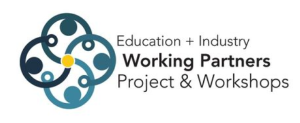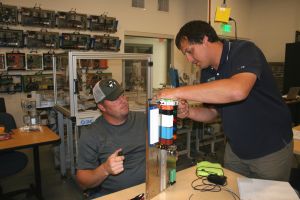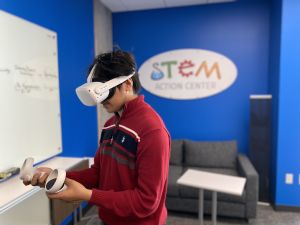




Principal investigators of five Advanced Technological Education initiatives shared information about their successes during the 2021 wrap-up session of ATE Office Hours.
V. Celeste Carter, the lead program director of the ATE program at the National Science Foundation, began the 60-minute virtual session on December 15 by encouraging the 100 people in attendance and the entire ATE community to participate in NSF’s COVID Diversity, Equity and Inclusion Challenge.
“That is something new for everybody to take a look at,” Carter said.
The challenge, which is segmented for four categories of higher education institutions, requires a three-page description of the evidence-based systemic actions taken to mitigate the negative impacts of the pandemic on diversity, equity, and inclusion in STEM. Narratives are due January 30.
“You’ve got time to do this. And colleges do not need to have a grant from NSF to enter the challenge,” Carter said.
In addition to the opportunity to present information about their program at an NSF virtual meeting, institutions in the various categories have the opportunity to win monetary prizes: $25,000 for first place; $15,000 for second place; and $10,000 for third place. Ten honorable mention certificates will also be awarded.
Working Partners’ Virtual-Hybrid Workshop Proves to be Effective
Mary Slowinski, principal investigator for the Working Partners Project & Workshops at Bellevue College in Washington, reported that a pandemic-induced shift in workshop delivery – from face-to-face to virtual-hybrid – proved highly effective for the initial cohort of 29 people from 17 institutions and three businesses.
The new format utilized an online course site to provide resources, methods, materials and collaboration tools, and 90-minute, once-a-week Zoom sessions. During these sessions participants learned about effective industry partnership strategies from experienced ATE principal investigators and industry leaders. The core materials for the workshop were drawn from the findings of the Working Partners Research Project, an ATE initiative from 2015 to 2020 that examined successes in education-industry partnering.
Rather than prescribe a particular course of action, participants are guided through the development of “an action plan of their own” based on their unique project goals and encouraged to learn from one another.
Post-workshop data indicate “significant and comprehensive improvement in participant confidence” for planning, building, and assessing partnerships. “We moved the needle,” Slowinski said, adding that “we were very pleased to see these results.”
Working Partners next cohort begins in February and a third cohort will begin meeting in June. For more info, write to workshop@workingpartnersproject.org
ATE Project Sparks Agricultural Science Enrollment Growth
Erin Krier attributes the tremendous growth in the agriculture program at Allan Hancock College in California to the Creating Precision Agriculture and Crop Protection Pathways via Industry Partnerships ATE project.
The project developed curriculum for three degrees – agricultural science, plant science, and agricultural business – and certificates in agricultural science, crop protection, and pest control advisor preparation.
The number of declared agricultural science majors increased from 109 students in 2018-2019 – the first year of the ATE project – to 329 in 2019-2020. That academic year the headcount enrollment in agricultural science was 488, including non-majors.
During 2020-2021 the headcount enrollment in agricultural science courses increased to 529 students. That was a 14% increase at a time when overall headcount at Allan Hancock College decreased by 8%.
“That was super exciting to see,” said Krier. She is principal investigator of the precision agriculture ATE project, an agriculture instructor, and coordinator of the college’s agricultural science program.
To recruit students, Krier and her colleagues emphasize the array of career opportunities that are open to people with agriculture science backgrounds. The college is a Hispanic-serving institution. During an interview, Krier said the opportunity for high-wage agricultural science careers appeals to the children of farm workers who weed and harvest crops on the large industrial farms and smaller family operations in Santa Barbara County. About 100 specialty crops are grown in the Central California county.
“A lot of them [students] are really in love with agriculture. They love plants. They are very interested in learning what’s going on with plants....But they want to do something that pays better and that’s not such back-breaking work, and they see there’s potential,” she said.
iMEC 2.0 Develops “Instructors in the Loop” for Mechatronics Courses
Doug Laven, principal investigator of Independent Mechatronics Education Curriculum 2.0 (iMEC 2.0), reported that despite COVID, the project had strong enrollment in its dual-enrollment mechatronics courses at rural high schools. It has had 65 students at five high school in Minnesota and 130 students at five high schools in Nebraska.
The project expands the uses of the independent Remote Experiment Automation Lab (iREAL) trainers (developed with a previous ATE grant) by offering intense professional development and long distance support to high school educators who serve as facilitators for lessons delivered by South Central College in Minnesota and Central Community College in Nebraska faculty via modules and instructional videos.
The project calls the high school teachers “Instructors in the Loop,” which evokes the tight connections between secondary school educators and the community college faculty who are the faculty-of-record for the courses that count toward two-year associate degrees.
Laven said the high school instructors are “our eyes in the classrooms.” As such, they influence the ongoing modifications of the courses. “We’re constantly lifting the hood on this curriculum and getting really good feedback from some of our facilitators,” he said.
LABS2 Podcasts with Temple Grandin Will Feature STEM Innovators
Unexpected survey results prompted leaders of the Linking Attitudes and Behaviors for Student Success (LABS2) project to rethink their approach for promoting technical careers.
Tamara L. Goetz, the principal investigator of LABS2 at the Utah STEM Action Center, reported that surveys found that it is a lack of information about technical careers, rather than negative opinions, that influence teens’ career decisions.
To give students and parents a more realistic understanding of career and technical education LABS2 is using social media, augmented reality, and virtual reality to explain technical careers.
It is also creating “How Did You Think of That?,” a podcast series narrated by Temple Grandin. It will share insights from scientists, inventors, and innovations about how they think and what is involved in their day-to-day work.
“It’s all about diverse thinking,” Goetz said. Grandin will interview guests from across the country, including ATE principal investigators, about their STEM-related innovations and the impact on education and student success.
Grandin, a Colorado State University professor of animal science, is known for developing humane practices for dealing with livestock, for writing about autism, and for advocating for people who think differently.
EvaluATE Provides Program-Wide Perspective
Erika Sturgis, who manages EvaluATE’s annual survey of ATE projects and centers, shared several findings from the newest ATE program survey.
EvaluATE data about what happened in the program during 2020 include the following:
- 25% of the students served by an ATE academic program were women, compared to 21% from 2019. (n=69)
- Over half of ATE projects emphasized recruitment of students from historically underrepresented racial or ethnic groups (66%) and women (64%). (n=55)
- Most of the new courses by ATE initiatives were either hybrid or online, rather than in-person. (n=303)
- 44% of ATE initiatives provided at least one type of service or support to students. (n=313)
- Most ATE initiatives offered workplace-based learning through internships, and increasingly via apprenticeships, than in 2019. (n=68)
EvaluATE is based at The Evaluation Center at Western Michigan University.

 Subscribe
Subscribe


 See More ATE Impacts
See More ATE Impacts

Comments
There are no comments yet for this entry. Please Log In to post one.